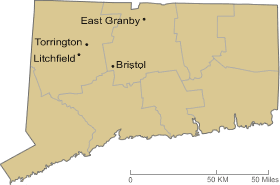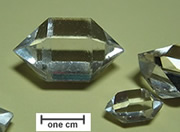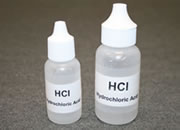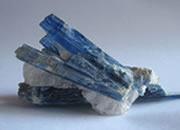Home » Minerals » Higley Copper and Copper Mining in Connecticut
The Higley Copper and Copper Mining in Connecticut
by John Carter copyright 2006

Higley Copper Coin: Obverse and reverse. Images by USMint.gov.
Higley Copper Coins
In 1737 Dr. Samuel Higley, a Yale Graduate, owned the Copper Hill Mine presently located in East Granby Connecticut on Newgate Rd. before the town was split off at a later date from Simsbury. Aside from being a medical doctor Dr. Higley was also a practicing blacksmith. He also had a great thirst, and the local innkeeper charged three pence a drink. Now, it doesn't take a degree from Yale to figure out what happened next. Aside from owning a copper mine, Dr. Higley also knew how to mint coins from that copper even if it was against Crown Law. So he proceeded to mint copper coins that he originally valued at three pence.
It wasn't long before the innkeeper had such a collection of these coins that he refused to take any more of them. Thereby Higley melted all of the coins down, and restruck them with the phrase on one side, "Value Me as You Please," and the other side had the phrase, "I Am Good Copper." No mention of the coins value was placed on them although Higley slyly placed the Roman numeral III on the obverse of the coin. The coins were used for a long time afterwards by goldsmiths to alloy with gold to make jewelry. This was a common practice until the early Twentieth Century when the coins became collectors' items, and vanished from the marketplace. His was the first copper mine, and for three years - 1737 to 1739 (although there are no coins dated 1738), he minted the first coins in America.
Early Copper Mining in Connecticut
Higley might have been first, but he sure wasn't the last, it wasn't too long before there were copper mines all over Connecticut, mostly in the Connecticut valley. Most of these mines were for catching suckers, but several of them produced economic amounts of copper ore. Most of these ores would have been considered "time and strata bound" if they were produced today. The most productive was found in the arkose of the Connecticut valley, although some copper ore was found in the Hartland Schist. There is one member of this schist that is metalliferous, and that is the Collinsville Schist, a member of the Hartland Schist Group.
The story of copper in Connecticut is now mostly forgotten, but in its heyday it was a considerable business. It is a story of murder, suicide and just about any other kind of chicanery you could dream up. It lasted for just about 200 years from early in the Eighteenth Century to the beginning of the Twentieth Century. The copper industry in America started in Copper Hill in Simsbury and ended in Bristol with mines strung up and down the Connecticut Valley, and smaller deposits being worked in the surrounding hills. For 200 years these mines along with mines in New Jersey, and Vermont gave birth to the copper and brass industries in the US. The brass industry was primarily located in the Naugatuck River Valley from Torrington south to Ansonia-Derby with the nexus of the business in Waterbury. It wasn't until late in the Twentieth Century that this business was dispersed from here, and there are plenty of companies in this area that still produce products made of brass and copper.
The two principal ores produced from these mines were chalcocite (copper glance) and bornite (peacock ore). To a lesser extent these mines produced native copper, cuprite (red copper ore), chalcopyrite (copper pyrite) and malachite (green copper ore). Chalcocite was the principle ore of the Simsbury Mines, and bornite was the principle ore at the Bristol Mine.

Map of Connecticut copper mines: Locations of Connecticut copper mines mentioned in this article.
Bristol Copper Mine
The richest of all these mines was reportedly the Bristol Copper Mine. This mine produced primarily bornite, and there is not a museum in the U.S. or Europe that doesn't display spectacular specimens of this ore. There were thousands of tons of copper ore mined at this site, but it never produced a plugged nickel's worth of profit. The reason for this was poor management. Everything they bought was the last word. They kept teams of fast horses on call for management. If a building was deemed to be unfit for their needs it was torn down, and a new identical building was raised in its place. This sounds like a sure way to snatch defeat from the jaws of victory, and it was. The company finally caused a flood that reached all the way to Forestville causing a great deal of property damage. Then it closed down for good. Reportedly, they left a large amount of high-grade ore in the ground, and a far greater amount of low-grade ore that would be economic under today's market conditions.
Platinum Group Metals
Another deposit that was worked for a few years was in Torrington in what is probably a lamproite. The particular ore produced here was actually a nickel-copper sulfide, and it had associated with this ore pentlandite that contained platinum group metals. In effect this was instant Monel Metal. According to the History of Torrington the first commercial nickel in the world was produced in West Torrington from this ore. To this day one of the brooks located here is called Nickelmine Brook because the smelter for this ore was located at the junction of this brook with the West Branch of the Naugatuck River. As recently as 1949 Falconbridge Mining of Canada conducted a diamond drilling program at this site. There is another of these lamproites located in Litchfield producing roughly the same mineralogy. On the other side of the state is a mafic intrusion known as the Preston Gabbro. The Foxwoods Casino is located on this intrusion, and according to the former chairman of the Mashantucket Pequots when they were drilling the wells for Foxwood's they found Platinum in the drill cuttings. There is also a large nugget of this metal in the Wesleyan Museum found in one of the rivers draining the Preston Gabbro.
About the Author
Article submitted by John Carter, 27 Greenwoods Garden, PO Box 282, Winsted, CT 06098, 860-248-9987 (cell), 860-238-7073 (land), geotekllc@netscape.net.
Biographical Note: I came into geology later in life than most geologists. The first 18 years of my working life was as an experimental machinist or a process engineer. I left this profession behind me in 1967, and for the next 12 years I was a commercial helicopter pilot. During this period I also earned my geology degrees. I couldn’t completely escape my early profession because after getting my degrees in geology I went into the environmental consulting business until I retired. At least this knowledge allowed me to know where the skeletons were buried, and who buried them. I still put in more than 8 hours a day on my latest reincarnation as a writer and photographer. I am single having been divorced for several years, and have no children.
| More Minerals |
 |
Herkimer Diamonds |
 |
The Acid Test |
 |
Tumbled Stones |
 |
Zircon |
 |
Fool*s Gold |
 |
Kyanite |
 |
Rock Tumblers |
 |
Rhodochrosite |

Find Other Topics on Geology.com:

|

| ||

|

| ||

|

| ||

|

|
